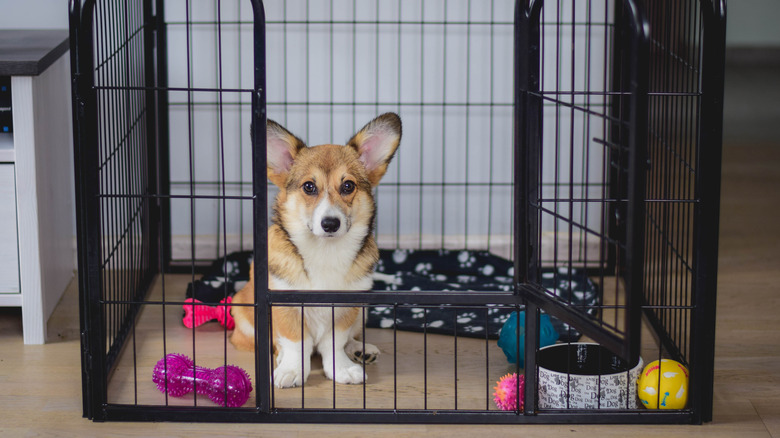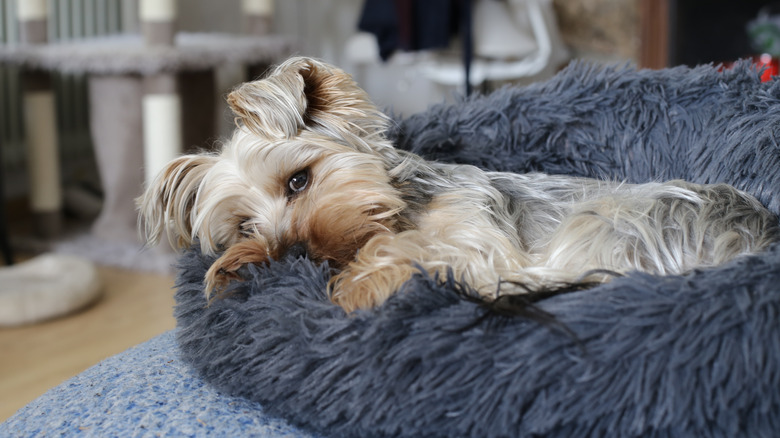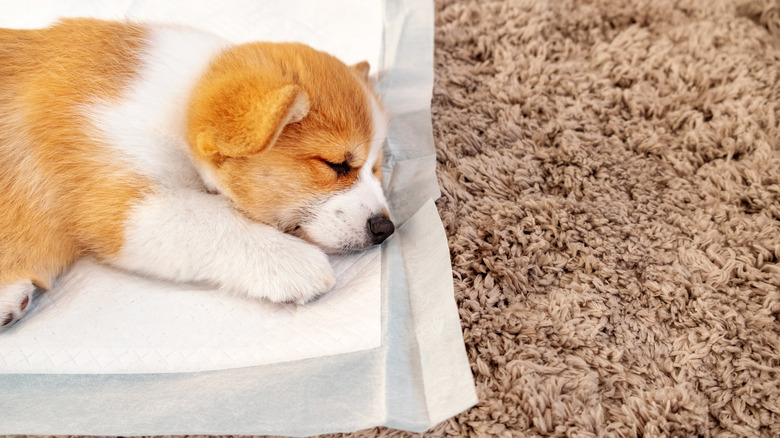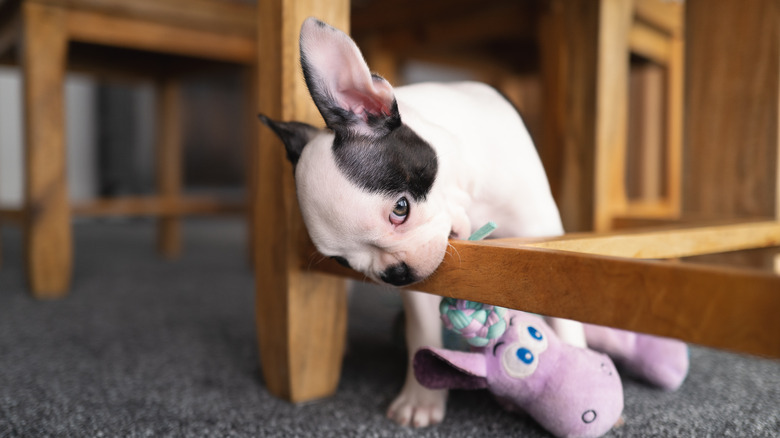How To Acclimate Puppies Into Your Home Without Damage, According To An Expert
There's nothing more exciting and nerve-wracking than bringing home a puppy. This new fuzzy family member will undoubtedly bring joy and wonder to your household. With unexplored sights, sounds, and smells galore, your puppy will want to search every inch of their territory to get a feel for what they can now consider home. This initial introduction to their environment can be important because they may have the urge to mark their area, especially if you currently have other dogs or have previously had pets in your home, according to the American Kennel Club.
To properly settle your puppy into their new space, it can help to have the direction of a professional to guide you on the right path. In an exclusive interview with House Digest, Veterinarian, MVZ, and Behaviorist with PetKeen, Dr. Paola Cuevas, tells us how you can integrate a puppy into your homestead without damage. "Bringing a new pet into your home is a great family moment that will come with certain challenges," Dr. Cuevas tells us, "When adopting a new puppy we are bringing in a living creature that is learning everything about its environment." Although it's perfectly normal for dogs to be excited about their new space, she advises new pet owners to "gradually introduce your puppy to different areas of your house," but notes "it is always recommended to supervise and keep a close eye on them and what they are doing."
Utilize a playpen
Your first day with your puppy will, unsurprisingly, be very exciting. To ensure that you have an ideal transition for your pup, there are plenty of things to consider so that you instill healthy habits so that they don't run amuck and tear into your residence. "Puppies are curious creatures and, just like human toddlers do, they learn about their environment and how to interact with it using their senses," says expert Dr. Paola Cuevas. "They will see, hear, touch, smell, and taste everything to gather all the necessary information about their environment components and stimuli." Because all areas of the home may not be so pet-friendly — such as an unfinished basement, home gym, or even important office space — it can be especially vital to set boundaries.
While it may be difficult to constantly keep the doors to these areas closed at all times, you may want to utilize a special spot for your petite pooch to give them their own space away from certain areas. "The best thing to invest in is a playpen where you can restrict your puppy's access to the different items in your home," advises Dr. Cuevas, "In this way, you can protect your puppy and also your belongings." Smaller dog breeds may need a pen with a height of up to 2.5 feet, with medium-sized dogs requiring a pen of 3 feet and larger breeds up to 6 feet.
Designate a sleeping area
During the first stages of introducing your dog to its new home, you'll need to set some ground rules for where they're allowed to be. When it comes to sundown on the first night, you don't want to be stuck wondering where they need to sleep. "The puppy's designated sleeping area should be planned and established from day one," says Veterinarian Dr. Paola Cuevas, "Bringing in a blanket that smells like their mum can help them feel familiar and safe." You can design the playpen to include a comfortable sleeping space for your puppy. By familiarizing them with new bedding in the enclosure, it can keep them off the couch or other pieces of furniture you don't want them on.
Before that happens, Dr. Cuevas suggests that you "Consider sleeping in the same room a puppy will sleep at least during the first few nights. This will help your puppy acclimate to its new environment and you can easily provide comfort when needed." Patience will be the name of the game as your pup adjusts to its new nighttime routine. "Just remember, your puppy was used to sleeping with its siblings and mum so this is the step when the sleeping alone experience is learned," she says, "Be nearby but do not let the puppy sleep in your bed unless this is how you are planning to have it for the rest of its life."
Prepare for potty training
Accidents happen, especially during the puppy potty training phase, so you want to do all you can to protect your floors, table legs, and pieces of furniture. "Potty training pads are a must-have," Dr. Paola Cuevas says, "Puppies have tiny bladders and they can not hold their pee for long periods. This also applies to nighttime, so do not expect to wake up to a clean area if your puppy was not brought outside to pee." Puppy pads are a perfect training tool in the early stages so that their urine doesn't soak into your carpet or ruin your hardwood floors. If your puppy does pee in a spot off of the pad, be prepared. Dr. Cuevas stresses that "While your puppy is learning, be patient and gentle, and never scream, get angry, or punish your puppy. You should invest time and effort in creating a positive and trust-based relationship."
To tidy up a fresh mess from your carpet, soak up the urine with a paper towel, then use cold water to wash out the rest. For older stains, consider an enzymatic cleaner to remove the odor and any discoloration. Luckily, "You can quickly learn to recognize the times and behavioral cues that indicate it needs to pee," she says, "Bringing the puppy to the designated potty area around this time is ideal. It is also recommended to bring them there about 15 minutes after a meal."
Protect your furniture while your puppy is teething
Puppies go through a teething process just like babies do. However, instead of a pacifier there for them to nibble on, they may resort to the legs of your furniture or even the trim to your floors. To put a stop to bad teething habits before they set in, Dr. Paola Cuevas has some advice. "Teething puppies go through several months of pain and discomfort while their deciduous teeth grow and fall and their permanent teeth grow," she tells us. "During this period a puppy will chew anything in their reach, so providing plenty of chew toys might not be enough to keep your furniture safe." However, this doesn't mean that your home décor and favorite furniture pieces are doomed to a slobbery scratched-up fate. Instead, there are ways to save your home from the jaws of your puppy.
"It is important to make it physically impossible for your puppy to reach your furniture," Dr. Cuevas advises, "Do not leave an unsupervised puppy in your living room. Provide a variety of toys to avoid boredom and give plenty of safe-to-chew alternatives." While their teething stage won't last forever, the sooner you establish good chewing practices, the better it will be for your home décor. This will also save you money on the cost of any gnawing-related repairs around your home as well as the added stress to you and your new puppy as they go through this stage of growth.




